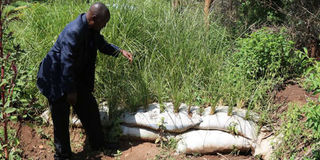Farmers use grass to reclaim land lost to erosion

Samuel Teimuge explaining how Vetipher grass is used to reclaim land and prevent soil erosion at his farm in Kerio Valley. PHOTO| FILE| NATION MEDIA GROUP
What you need to know:
- The rain water from the highlands, creating huge gullies that have rendered the once fertile farms in Elgeyo Marakwet County waste lands.
- The grass grows very fast and is drought resistant. Teimuge was able to reclaim part of his farm with huge gullies, in three rain seasons, and is now using it to grow crops.
- Elgeyo Marakwet Chief Officer in charge of Agriculture Mr Pius Cheserek notes that the initiative has assisted in control of erosion.
For years, thousands of acres of land in Kerio Valley have been washed away by rain water from the highlands, creating huge gullies that have rendered the once fertile farms in Elgeyo Marakwet County waste lands.
This trend is set to be reversed thanks to the adoption of vetipher grass, which reclaims the land and restores it back to productivity. The plant was introduced by Samuel Teimuge, who got it from a friend in Bondo, Siaya County in 2014. Teimuge sold the seedlings to 30 farmers and went on to form a community-based organisation Konya Soy, which means heal Soy.
The grass grows very fast and is drought resistant. Teimuge was able to reclaim part of his farm with huge gullies, in three rain seasons, and is now using it to grow crops.
At first, he planted the grass in sacks at intervals in the gullies and when storm water came, they filled up the ravines with soil which then compacted to reclaim the areas previously washed away.
When planted in single lines along the contour, hedges of vetipher are very effective in soil and moisture conservation. Apart from controlling soil erosion, the drought-resistant grass can be fed to cows.
CONTROLLING SOIL EROSION
Another benefit of the plant is that it is self-propagating and thus does not require replanting. Its roots also grow deep at 15 feet under the soil and hence raging floods cannot easily uproot them.
The grass can also grow up to six meters tall and Teimuge says this is advantageous since a farmer can grow crops in between the grass and benefit from a cover that shields the crops from birds which always eat their produce.
With the CBO, he notes, farmers can harvest the grass for the manufacture of products such as mats, hats, brooms to supplement their income.
Elgeyo Marakwet Chief Officer in charge of Agriculture Mr Pius Cheserek notes that the initiative has assisted in control of erosion.
“This topography has allowed rain water to always flow down to the valley in large quantities due to the terrain as a result, a lot of fertile soil is washed away and this poses a major food security challenge in our County,” he said.
Cheserek said the devolved unit is supporting initiatives aimed at restoring the areas degraded by soil including growth of the grass as well as promotion of soil erosion prevention programmes.




